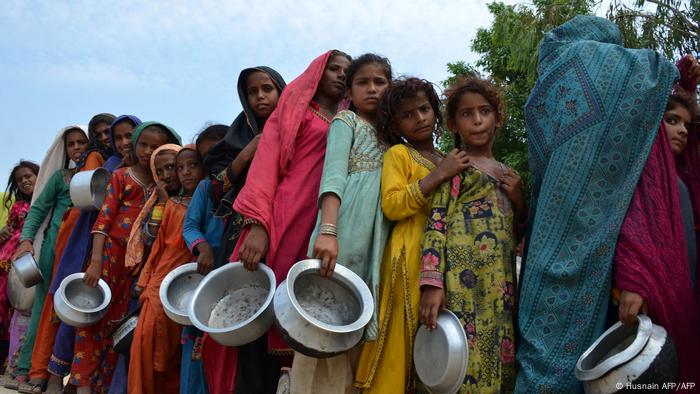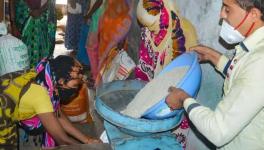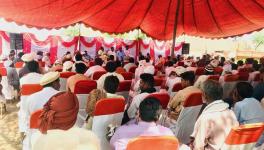Pakistan Floods Threaten Food Security as Critical Crops Destroyed
International donors are providing food assistance as Pakistan's breadbasket has been flooded
Flooding in dozens of districts in Pakistan's Balochistan, Sindh and Punjab provinces have destroyed wide swaths of agricultural land.
The country could soon face food shortages if thousands of acres of cropland aren't restored.
"We are concerned that if the farmlands aren't drained right now, we won't be able to plant crops for winter season, the most important of which is the wheat crop," Nazia Bibi, a farmer in Balochistan's Pishin district, told DW.
The damage to the agricultural sector has caused the government to warn of a looming food security crisis. It is already having to import tomatoes and onions from neighboring Afghanistan and Iran.
A vendor in the capital Islamabad told DW that he was currently unable to buy new stocks of vegetables to sell.
"I am waiting for the imported stock of onions and tomatoes to reach the warehouses so we can sell those," he said, sitting next to his cart full of onions, which were mostly rotten.
Food assistance needed
Pakistan's National Disaster Management Agency (NDMA) is leading relief efforts in coordination with the United Nations and other international organizations.
The United Nation's World Food Programme (WFP) has so far provided over 464,000 people in Balochistan, Khyber Pakhtunkhwa (KP) and Sindh with relief food assistance.
The WFP added that it aims to expand this to 1.9 million people facing food insecurity in flood-affected districts, according to a September situation report.
Displaced flood-affected people stand in a queue to receive food in Sindh province
"The intensity of the situation in villages is such that people are snatching ration packs from each other during distribution drives," said Abid Mir, a social activist and professor at a university in Sindh. "It's really heartbreaking to see that."
Some of the food relief is coordinated by the National Disaster Management Agency, who organizes the distribution of aid to their provincial counterparts.
Other food relief is being distributed directly by international organizations, said Muhammad Younas, an official at Balochistan's Provincial Disaster Management Authority.
"International NGOs have their own local partners who they give their aid to. They have their own mechanism and ways of assessing the damages and victims' needs," he told DW.
"They, however, must get permission from the government to work in a particular area.".
Although Pakistan's government plans to provide cash payments to over 4.5 million flood-affected households through the Benazir Income Support Programme, it has been criticized for not doing enough to prepare for the monsoon season.
Saqlain Abbas, a farmer in Punjab state's Rajanpur district, said the government hadn't done enough to protect people's homes and land.
"For years, my family has been reliant on cultivating rice and wheat to feed ourselves and now all our crops have been submerged in water," he said.
The WFP said it will begin climate resilience programs next year in Pakistan by "improving community infrastructure."
However, economist Kaiser Bengali, says that it won't be easy for the Pakistani government to attract a large amount of aid to make the country more flood resilient.
"One, there is a donor fatigue," he said. "Two, Pakistan needs to slash non-development expenditure, including the non-combatant defense budget, ration petrol and ban non-essential imports to generate more money that will be required for flood rehabilitation."
Economic impact of flooded agricultural sector
The monsoon floods come as Pakistan is facing an ongoing economic crisis, with high inflation making food staples more expensive.
Pakistan is also a major exporter of agricultural products and the flood damage will likely cut into a vital source of income.
Pakistan is the world's fourth-largest exporter of rice, for example.
According to the nation's Bureau of Statistics, Pakistan exported a record $2.5 billion (€2.5 billion) worth of rice during the 2021-22 fiscal year.
Flood-stricken Sindh province accounts for 42% of that rice production. A report assessing crop loss in Sindh conducted by the International Centre for Integrated Mountain Development, a Nepal-based research organization, shows that flooding was particularly severe in rice-growing areas.
This has resulted in the estimated loss of 1.9 million tons (1.7 million tonnes) of rice, equivalent to an 80% loss of the province's forecast rice production.
Combined with an 88% loss of sugarcane and 61% loss of cotton, the total economic impact is worth $1.3 billion in Sindh alone, according to the report.
Three key vegetable crops in several districts in Sindh — tomatoes, onions and chili — face losses of $374 million, it added.
Edited by: Wesley Rahn
Get the latest reports & analysis with people's perspective on Protests, movements & deep analytical videos, discussions of the current affairs in your Telegram app. Subscribe to NewsClick's Telegram channel & get Real-Time updates on stories, as they get published on our website.

























